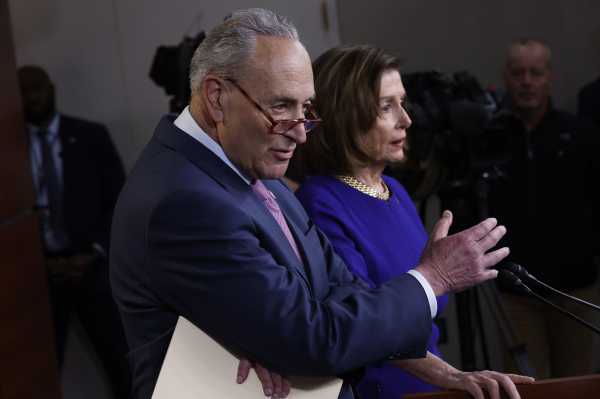
With Republicans still projected to retake the House, Democrats are increasingly eyeing an urgent priority during the final months of the legislative session: raising the debt ceiling.
Addressing the debt ceiling, which essentially involves increasing the amount that the United States is able to borrow, is a routine congressional duty. Failing to do so would cause the US to default on its debt, triggering a global financial crisis. Recently, House Minority Leader Kevin McCarthy (R-CA) suggested he’d be willing to risk such a crisis as speaker of the House, if doing so won the GOP serious spending cuts to climate and social programs.
“We’re not just going to keep lifting your credit card limit,” McCarthy told Punchbowl News last week. “And we should seriously sit together and [figure out], where can we eliminate some waste?”
McCarthy’s comments are now spurring Democrats to consider heading off any such possibility by increasing the debt ceiling during the lame-duck period (after the November elections, when Congress returns from its current recess). Doing so could be the only way to completely avoid the disastrous prospect of a debt default if lawmakers aren’t able to reach an agreement next year.
Why Democrats want to raise the debt ceiling now
The US is currently projected to hit its existing debt ceiling sometime in 2023, according to the Bipartisan Policy Center. While raising the ceiling should be relatively straightforward, it’s become a contentious process — and an opportunity for the minority party to extract policy concessions or score political points. Both parties have used debt ceiling increases to their advantage, but Republicans have done so much more frequently in recent years.
In 2011, for example, Republicans balked on suspending the debt limit and refused to move forward until President Barack Obama agreed to key spending cuts, concessions they ultimately secured. The US got so close to default that year, however, that Standard and Poor’s downgraded the country’s credit rating.
Political experts note that this disagreement marked one of the first times it seemed like lawmakers were actually willing to go over the edge, despite the economic chaos that could ensue. Were the US to actually default, that would likely downgrade the dollar and lead to a recession.
While a default has never happened, Republicans’ behavior in 2011 — and their current rhetoric — suggests that they’re more open to the possibility and taking such fights to that point.
Democrats, including in the White House, are reportedly considering preempting this worst-case scenario by tackling the debt ceiling this winter, according to Axios. The White House has denied that such conversations are happening.
There are also still questions about what a debt ceiling bill could look like. While some lawmakers including Sen. Jeanne Shaheen (D-NH), and a group of prominent House Democrats, have expressed support for doing away with the debt ceiling altogether, others, like Biden and Sen. Bernie Sanders (I-VT), have opposed taking this route. That’s likely because such talks still offer an opportunity to evaluate spending, and because it could be a useful tool for Democrats should the GOP hold the White House and Congress.
In lieu of getting rid of the debt limit altogether, there’s been growing pressure on Democrats to consider increasing it to such a high value that there isn’t likely to be a standoff over the issue in the short term.
Were Democrats to get this done this year, they could also be doing McCarthy a favor, especially if his party ends up narrowly controlling the House. With debt ceiling drama off the table, McCarthy won’t have to worry about wrangling the more extremist factions of his party who may be more open to default, and completely unwilling to settle for anything but the most aggressive cuts to social spending.
How Democrats could do it during the lame-duck session
There are a few options available to Democrats if they want to raise the debt ceiling.
The first is to pass an increase through regular order. Because of the filibuster, lawmakers in the Senate need 60 votes to advance most bills, meaning Democrats’ 50-person majority would require 10 Republicans to join them in order to approve any increase. Given Republicans’ reluctance to vote for an addition to the debt ceiling last year, it’s uncertain that position would change this time around, especially if the party is hoping to use this policy as a tool in 2023.
The second option is to pass an increase by establishing a carveout to the filibuster, something the Senate effectively did last year when Republicans wouldn’t support a debt ceiling increase. A carveout would allow Democrats to pass legislation with a simple majority and do away with the 60-vote threshold specifically on this issue.
Due to Sens. Joe Manchin (D-WV) and Kyrsten Sinema’s (D-AZ) reluctance to make changes to the filibuster rules, however, it’s not clear if they would agree to using this avenue. Last year, Manchin and Sinema only got on board because Democrats and Republicans had agreed to a deal for a one-time carveout.
The third option is to use budget reconciliation again. Doing so would also only require a simple majority, which means Democrats could do it on their own with 50 votes and Vice President Kamala Harris serving as a tie breaker. The downside of using this process — as has been evident with other bills — is that it can be time-consuming, since it requires passing both a budget resolution and a final bill, as well as a taxing vote-a-rama on amendments. It’s not guaranteed Democrats would have enough time — or, again, the support from Manchin and Sinema — to successfully pursue this route, either.
Regardless of the approach they take, Democrats face a tight timeline. Besides potential action on the debt ceiling, lawmakers have several other must-pass bills to contend with, including government funding and the National Defense Authorization Act, which establishes budgets for the military. On top of these routine bills, Democrats also have limited time to advance other key priorities like protections for same-sex marriage and the Electoral Count Reform Act, which is intended to make it more difficult to challenge the outcome of presidential election results.
Political experts have also wondered if lawmakers will actually feel an impetus to get anything done if the final default deadline isn’t imminent. Traditionally, Congress has been known for procrastinating, and hasn’t raised the limit until close to the last possible moment.
Still, approving a debt ceiling increase this year could save Democrats, and the country, a major headache in 2023 — a reason that could be motivation enough.
Will you support Vox’s explanatory journalism?
Millions turn to Vox to understand what’s happening in the news. Our mission has never been more vital than it is in this moment: to empower through understanding. Financial contributions from our readers are a critical part of supporting our resource-intensive work and help us keep our journalism free for all. Please consider making a contribution to Vox today.
Sourse: vox.com






